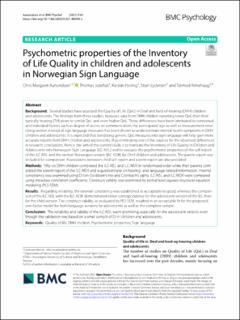| dc.contributor.author | Aanondsen, Chris Margaret | |
| dc.contributor.author | Jozefiak, Thomas | |
| dc.contributor.author | Heiling, Kerstin | |
| dc.contributor.author | Lydersen, Stian | |
| dc.contributor.author | Rimehaug, Tormod | |
| dc.date.accessioned | 2021-10-22T07:25:07Z | |
| dc.date.available | 2021-10-22T07:25:07Z | |
| dc.date.created | 2021-05-27T23:48:44Z | |
| dc.date.issued | 2021 | |
| dc.identifier.citation | BMC Psychology. 2021, 9 (1), 89-?. | en_US |
| dc.identifier.issn | 2050-7283 | |
| dc.identifier.uri | https://hdl.handle.net/11250/2824871 | |
| dc.description.abstract | Background
Several studies have assessed the Quality of Life (QoL) in Deaf and hard-of-hearing (DHH) children and adolescents. The findings from these studies, however, vary from DHH children reporting lower QoL than their typically hearing (TH) peers to similar QoL and even higher QoL. These differences have been attributed to contextual and individual factors such as degree of access to communication, the participants’ age as well as measurement error. Using written instead of sign language measures has been shown to underestimate mental health symptoms in DHH children and adolescents. It is expected that translating generic QoL measures into sign language will help gain more accurate reports from DHH children and adolescents, thus eliminating one of the sources for the observed differences in research conclusions. Hence, the aim of the current study is to translate the Inventory of Life Quality in Children and Adolescents into Norwegian Sign Language (ILC-NSL) and to evaluate the psychometric properties of the self-report of the ILC-NSL and the written Norwegian version (ILC-NOR) for DHH children and adolescents. The parent report was included for comparison. Associations between child self-report and parent-report are also provided.
Methods
Fifty-six DHH children completed the ILC-NSL and ILC-NOR in randomized order while their parents completed the parent-report of the ILC-NOR and a questionnaire on hearing- and language-related information. Internal consistency was examined using Dillon-Goldstein’s rho and Cronbach’s alpha, ILC-NSL and ILC-NOR were compared using intraclass correlation coefficients. Construct validity was examined by partial least squares structural equation modeling (PLS-SEM).
Results
Regarding reliability, the internal consistency was established as acceptable to good, whereas the comparison of the ILC-NSL with the ILC-NOR demonstrated closer correspondence for the adolescent version of the ILC than for the child version. The construct validity, as evaluated by PLS-SEM, resulted in an acceptable fit for the proposed one-factor model for both language versions for adolescents as well as the complete sample.
Conclusion
The reliability and validity of the ILC-NSL seem promising, especially for the adolescent version, even though the validation was based on a small sample of DHH children and adolescents. | en_US |
| dc.language.iso | eng | en_US |
| dc.publisher | BMC | en_US |
| dc.rights | Navngivelse 4.0 Internasjonal | * |
| dc.rights.uri | http://creativecommons.org/licenses/by/4.0/deed.no | * |
| dc.title | Psychometric properties of the Inventory of Life Quality in children and adolescents in Norwegian Sign Language | en_US |
| dc.type | Peer reviewed | en_US |
| dc.type | Journal article | en_US |
| dc.description.version | publishedVersion | en_US |
| dc.source.pagenumber | 89-? | en_US |
| dc.source.volume | 9 | en_US |
| dc.source.journal | BMC Psychology | en_US |
| dc.source.issue | 1 | en_US |
| dc.identifier.doi | 10.1186/s40359-021-00590-x | |
| dc.identifier.cristin | 1912395 | |
| cristin.ispublished | true | |
| cristin.fulltext | original | |
| cristin.qualitycode | 1 | |

